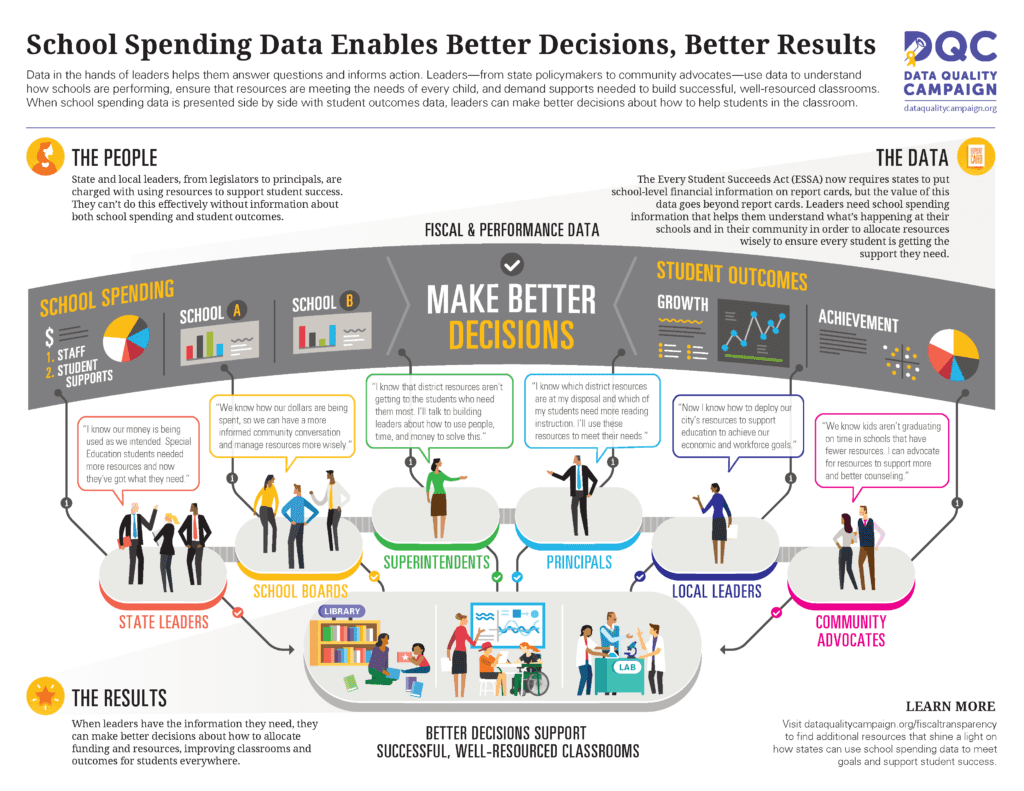
The Every Student Succeeds Act (ESSA) charged states with developing high-quality education goals that further the outcomes of all students. Regardless of the goals outlined in your state’s ESSA plan, data is needed to measure progress and identify best practices. DQC created a series of resources that shine a light on how states can use data to meet these different education goals and support student success.
Build Better Report Cards
Only a few states have provided families and communities with a report card that demonstrates student and school progress in clear language with useful context. States should take advantage of the data they are already collecting and make that information more accessible and meaningful.
- State Guide to Building Online School Report Cards is a 12-month, step-by-step guide to help leaders think through the process and timeline of developing high-quality report cards.
- Show Me the Data explores the current landscape of state report cards, including steps that states can take today to put this information in the hands of all stakeholders.
- States Can and Must Include Postsecondary Enrollment Data on Report Cards highlights how states can share information on the outcomes of their high school graduates to paint a fuller picture of student transitions after K–12.
- School Spending Data Enables Better Decisions, Better Results illustrates how leaders at all levels can use school-level spending data, as required by ESSA, to ensure successful, well-resourced classrooms.
Combat Achievement and Opportunity Gaps
ESSA charges states to highlight and act on inequities at every level of the education system. States should strive to go farther than the requirements of the law to better serve every student.
- Growth Data: It Matters, and It’s Complicated explores the different ways states have committed to measuring student growth and ESSA and what that means for the questions stakeholders can and can’t answer about students and schools in their community.
- Shining a Light on Equity spotlights how states have successfully used data to address performance gaps, and helps educators and leaders ensure that all students have the support they need.
Work Across Sectors to Better Support Students
- Roadmap for Cross-Agency Data Governance breaks down the first step states must take to ensure secure cross-agency data sharing is possible: the development of a high-quality data governance structure.
- Roadmap for Foster Care and K–12 Data Linkages demonstrates the importance of data sharing between child welfare and education agencies to better coordinate and target student services. These data linkages are also the first step in meeting ESSA’s new foster care reporting requirements.
- Roadmap for K–12 and Workforce Data Linkages explores how states can ensure students transitioning out of high school are trained with the skills needed to meet job demands.
- Thinking beyond the School Day explores how states can leverage ESSA to strengthen data-driven partnerships between schools and out-of-school time (OST) programs. Community partners are important stakeholders in student success and partnerships between OST programs and schools can improve student outcomes both inside and outside of the classroom.
Put a Learner-Ready Teacher in Every Classroom
- Using Data to Ensure That Teachers Are Learner Ready on Day One highlights how states can lead the way by making sure all stakeholders involved in preparing and supporting educators have the information they need for continuous improvement.
- Teacher Data Literacy: It’s About Time breaks down the actions policymakers can take to ensure teachers have the skills needed to use data in service of student learning.
- Administrator Data Literacy Fosters Student Success illustrates how data-literate administrators create a culture of effective data use in districts and schools. States can learn more about their role in ensuring all administrators are empowered with the skills to make this happen.
Use Research and Evidence in Service of Student Learning
ESSA provides states with the flexibility to choose the types of evidence that best help them identify and invest in resources and interventions suited to their communities’ needs. States can and should build research-practice partnerships that help leaders at every level answer critical education questions and identify which policies lead to greater outcomes for students.
- Roadmap for Effective Data Use and Research Partnerships between State Education Agencies and Education Researchers explores how state leaders can partner with researchers to answer critical education questions.
- Improving Education Outcomes by Building Data-Driven Relationships breaks down what researchers and state leaders should discuss to develop an effective partnership.
- Resources to Support Evidence-Based Decisionmaking in States is a one-stop shop for resources states can use to strengthen the use of evidence in education policy decisionmaking.
Increasing Graduation Rates—and Ensuring It’s Based on Quality Data
Sealing the Cracks: Using Graduation Data, Policy, and Practice to Keep All Kids on Track discusses how to improve the quality and comparability of graduation data, which builds trust and utility in this information to ultimately help more students graduate.
Shine a Light on School Spending
Using Financial Data to Support Student Success breaks down the steps states can take to meet ESSA’s fiscal transparency requirements and improve transparency with the public.
School Spending Data Enables Better Decisions, Better Results illustrates what it looks like when leaders – from state and local policymakers to principals and community advocates – use school-level spending data in their roles to ensure successful, well-resourced classrooms.
View the infographic:


